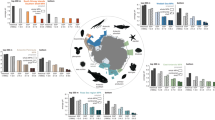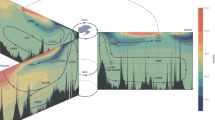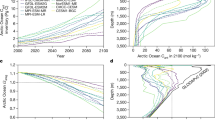Abstract
Ocean acidification may lead to seasonal aragonite undersaturation in surface waters of the Southern Ocean as early as 2030 (ref. 1). These conditions are harmful to key organisms such as pteropods2, which contribute significantly to the pelagic foodweb and carbon export fluxes in this region3. Although the severity of ocean acidification impacts is mainly determined by the duration, intensity and spatial extent of aragonite undersaturation events, little is known about the nature of these events, their evolving attributes and the timing of their onset in the Southern Ocean. Using an ensemble of ten Earth system models, we show that starting around 2030, aragonite undersaturation events will spread rapidly, affecting ∼30% of Southern Ocean surface waters by 2060 and >70% by 2100, including the Patagonian Shelf. On their onset, the duration of these events will increase abruptly from 1 month to 6 months per year in less than 20 years in >75% of the area affected by end-of-century aragonite undersaturation. This is likely to decrease the ability of organisms to adapt to a quickly evolving environment4. The rapid equatorward progression of surface aragonite undersaturation can be explained by the uptake of anthropogenic CO2, whereas climate-driven physical or biological changes will play a minor role.
This is a preview of subscription content, access via your institution
Access options
Subscribe to this journal
Receive 12 print issues and online access
$209.00 per year
only $17.42 per issue
Buy this article
- Purchase on Springer Link
- Instant access to full article PDF
Prices may be subject to local taxes which are calculated during checkout



Similar content being viewed by others
References
McNeil, B. I. & Matear, R. J. Southern Ocean acidification: A tipping point at 450-ppm atmospheric CO2 . Proc. Natl Acad. Sci. USA 105, 18860–18864 (2008).
Bednaršek, N. et al. Extensive dissolution of live pteropods in the Southern Ocean. Nature Geosci. 5, 881–885 (2012).
Hunt, B. P. V. et al. Pteropods in Southern Ocean ecosystems. Prog. Oceanogr. 78, 193–221 (2008).
Sunday, J. M. et al. Evolution in an acidifying ocean. Trends Ecol. Evol. 29, 117–125 (2014).
Sarmiento, J. L., Gruber, N., Brzezinski, M. A. & Dunne, J. P. High-latitude controls of thermocline nutrients and low latitude biological productivity. Nature 427, 56–60 (2004).
Gruber, N. et al. Oceanic sources, sinks, and transport of atmospheric CO2 . Glob. Biogeochem. Cycles 23, 1–21 (2009).
Brooks, C. M. Competing values on the Antarctic high seas: CCAMLR and the challenge of marine-protected areas. Polar J. 3, 277–300 (2013).
Schofield, O. et al. How do polar marine ecosystems respond to rapid climate change? Science 328, 1520–1523 (2010).
Bromwich, D. H. et al. Central West Antarctica among the most rapidly warming regions on Earth. Nature Geosci. 6, 139–145 (2012).
Kawaguchi, S. et al. Risk maps for Antarctic krill under projected Southern Ocean acidification. Nature Clim. Change 3, 843–847 (2013).
Orr, J. C. et al. Anthropogenic ocean acidification over the twenty-first century and its impact on calcifying organisms. Nature 437, 681–686 (2005).
Ries, J. B., Cohen, A. L. & McCorkle, D. C. Marine calcifiers exhibit mixed responses to CO2-induced ocean acidification. Geology 37, 1131–1134 (2009).
Tebaldi, C. & Knutti, R. The use of the multi-model ensemble in probabilistic climate projections. Phil. Trans. R. Soc. A 365, 2053–2075 (2007).
Friedrich, T. et al. Detecting regional anthropogenic trends in ocean acidification against natural variability. Nature Clim. Change 2, 167–171 (2012).
Hauri, C., Gruber, N., McDonnell, A. M. P. & Vogt, M. The intensity, duration, and severity of low aragonite saturation state events on the California continental shelf. Geophys. Res. Lett. 40, 1–5 (2013).
Orr, J. C. in Ocean Acidification Vol. 2 (eds Gattuso, J.-P. & Hansson, L.) 41–66 (Oxford Univ. Press, 2011).
Wood, H. L., Spicer, J. I. & Widdicombe, S. Ocean acidification may increase calcification rates, but at a cost. Proc. Biol. Sci. 275, 1767–1773 (2008).
Seibel, B. A., Maas, A. E. & Dierssen, H. M. Energetic plasticity underlies a variable response to ocean acidification in the pteropod, Limacina helicina antarctica. PLoS ONE 7, e30464 (2012).
IPCC Climate Change 2013: The Physical Science Basis (eds Stocker, T. F. et al.) (Cambridge Univ. Press, 2013).
Hauri, C. et al. Inorganic carbon dynamics along the Western Antarctic Peninsula from 1998 until 2013. Biogeosci. Discuss. 12, 6929–6969 (2015).
McNeil, B. I., Sweeney, C. & Gibson, J. A. E. Short note: Natural seasonal variability of aragonite saturation state within two Antarctic coastal ocean sites. Antarct. Sci. 23, 411–412 (2011).
Lewis, C. N., Brown, K. A., Edwards, L. A., Cooper, G. & Findlay, H. S. Sensitivity to ocean acidification parallels natural pCO2 gradients experienced by Arctic copepods under winter sea ice. Proc. Natl Acad. Sci. USA 110, E4960–E4967 (2013).
Espinoza, P. & Bertrand, A. Revisiting Peruvian anchovy (Engraulis ringens) trophodynamics provides a new vision of the Humboldt Current system. Prog. Oceanogr. 79, 215–227 (2008).
Montecino, V. & Lange, C. B. The Humboldt current system: Ecosystem components and processes, fisheries, and sediment studies. Prog. Oceanogr. 83, 65–79 (2009).
Bisbal, G. A. The Southeast South American shelf large marine ecosystem. Mar. Policy 19, 21–38 (1995).
Carrillo, C. J., Smith, R. C. & Karl, D. M. Processes regulating oxygen and carbon dioxide in surface waters west of the Antarctic Peninsula. Mar. Chem. 84, 161–179 (2004).
Bednaršek, N., Tarling, G. A., Fielding, S. & Bakker, D. C. E. Population dynamics and biogeochemical significance of Limacina helicina antarctica in the Scotia Sea (Southern Ocean). Deep-Sea Res. II 59–60, 105–116 (2012).
Meijers, A. J. S. The Southern Ocean in the coupled model intercomparison project phase 5. Phil. Trans. R. Soc. A 372, 20130296 (2014).
Doney, S. C., Fabry, V. J., Feely, R. A. & Kleypas, J. A. Ocean acidification: The other CO2 problem. Ann. Rev. Mar. Sci. 1, 169–192 (2009).
Hauck, J. et al. On the Southern Ocean CO2 uptake and the role of the biological carbon pump in the 21st century. Glob. Biogeochem. Cycles http://dx.doi.org/10.1002/2015GB005140 (2015).
Montes-Hugo, M. et al. Recent changes in phytoplankton communities associated with rapid regional climate change along the western Antarctic Peninsula. Science 323, 1470–1473 (2009).
Hoppe, C. J. M., Holtz, L.-M., Trimborn, S. & Rost, B. Ocean acidification decreases the light-use efficiency in an Antarctic diatom under dynamic but not constant light. New Phytol. http://dx.doi.org/10.1111/nph.13334 (2015).
Midorikawa, T. et al. Decreasing pH trend estimated from 35-year time series of carbonate parameters in the Pacific sector of the Southern Ocean in summer. Deep-Sea Res. I 61, 131–139 (2012).
Acknowledgements
We acknowledge support from the National Science Foundation Ocean Acidification Program (OCE-1314209). This is IPRC publication no. 1152 and SOEST publication no. 9508.
Author information
Authors and Affiliations
Contributions
T.F. prepared and analysed the model output. C.H. analysed the model output and wrote the paper. All authors were involved in the study design, discussed the results and commented on the manuscript.
Corresponding author
Ethics declarations
Competing interests
The authors declare no competing financial interests.
Supplementary information
Rights and permissions
About this article
Cite this article
Hauri, C., Friedrich, T. & Timmermann, A. Abrupt onset and prolongation of aragonite undersaturation events in the Southern Ocean. Nature Clim Change 6, 172–176 (2016). https://doi.org/10.1038/nclimate2844
Received:
Accepted:
Published:
Issue Date:
DOI: https://doi.org/10.1038/nclimate2844
This article is cited by
-
Severe 21st-century ocean acidification in Antarctic Marine Protected Areas
Nature Communications (2024)
-
Assessing the remaining carbon budget through the lens of policy-driven acidification and temperature targets
Climatic Change (2023)
-
Warming, not CO2-acidified seawater, alters otolith development of juvenile Antarctic emerald rockcod (Trematomus bernacchii)
Polar Biology (2021)
-
Strong time dependence of ocean acidification mitigation by atmospheric carbon dioxide removal
Nature Communications (2019)
-
Sudden emergence of a shallow aragonite saturation horizon in the Southern Ocean
Nature Climate Change (2019)



